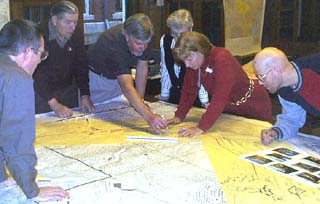
Surveys
DJC.COM
November 21, 2002
Engaging the community with 'Design Dialogue'
Otak

Roberts |
We’ve all been there. Well, maybe not on the chain gang or “in the box,” but most planners, architects, engineers and design professionals have been in frustrating meetings, directly experiencing the challenges related to establishing good communications in the public involvement process. Those sometimes grueling and long drawn-out steps of taking a project through public review and approval can be mind-boggling.
Establishing strong and positive communications with the communities we work in shouldn’t be such a struggle.
Why is it that some of the most stunning works of art and architecture fail to gain the acceptance and support of the communities that surround them? Why do planning commissions and elected officials sometimes fail to approve or adopt some of the best-conceived land use plans and development proposals even though all the regulatory requirements are met?
Responding to the community
Unfortunately, there are plenty examples of plans and projects that never make it off the drawing board because they don’t adequately respond to the needs and characteristics of the community. Worse yet, design professionals often believe they understand the desires of the community and proceed to take their projects through design, only to find out too late that they didn’t actually get the full community perspective.
In other words, not all the community groups and stakeholders who should have been at the table were there during the early stages of conceiving the project. In addition, projects typically will experience problems and delays if there is a lack of good rapport with the staff of the public agency or agencies involved in reviews and approvals.

Photo courtesy Otak Roger Millar, Otak principal, leads the Design Dialogue in the Eastern Allegheny County Light Rail Study in Pittsburgh.
|
Even the best planners and designers won’t succeed if they don’t actively engage the community in the process of creating their projects. Being able to win public support takes more than good communication. It takes a clear understanding of the political framework of the community and the ability to bring key groups and individuals into the process early enough so that they can help shape the solutions.
Unlike Cool Hand Luke, planners and designers must be willing to conform. Our plans and designs need to be tailored to fit the community’s expressed consensus.
So how do we successfully navigate the public arena? How can we avoid the dreaded “failure to communicate?” What is the formula for turning the sometimes difficult and arduous process of public involvement into an engaging, effective and fun (yes, fun!) experience?
The Design Dialogue
Otak has developed a unique process as a new tool for efficiently and actively involving community leaders and organizations, agency staff, key project stakeholders, and the general public in planning and design of projects. We call it the “Design Dialogue.”
It consists of a series of interactive workshops held over an intensive period of time — several days to a week, typically — right in the heart of the community during the earlier stages of a planning or design project.
The Design Dialogue project team sets up shop at the local community center, library, school or other venue. With tables, chairs, background reports, maps, aerial photos, drawing paper, pens and other resources in-hand, the planners and designers sit down with various groups of people in pre-scheduled, structured work sessions.
One of the most beneficial outcomes of the Design Dialogue process is the development of a successful partnership between community representatives, staff, and the project proponents. From the outset, the project team builds trust and begins to foster a positive and supportive relationship with decision-makers and influential groups and individuals by genuinely engaging them in the process and responding to their concerns.
This process has been effective for a diversity of projects. Some examples of Otak’s work that have integrated the Design Dialogue approach include:
- a conceptual study for an 18-mile light-rail corridor in Eastern Allegheny County, Pittsburgh;
- corridor concept planning for four major arterials in Tempe, Ariz.;
- development of a streetscape master plan in Yorktown, Ind.;
- public transportation feasibility study in Blaine County, Idaho; and
- a community design report for transit-oriented development for the Glenwood Springs to Aspen corridor in Colorado.
The process has also been used successfully to develop land use policy, with the City of Tempe, Arizona, Development Code Rewrite project, where designers conducted case studies of proposed code revisions.
The Design Dialogue process is organized so that community representatives, stakeholders, and staff with like interests and concerns are invited to come to their own specific work sessions. Here, the organization or citizens group is able to have its very own forum. Participants in these sessions don’t have to compete with others to be heard and share their ideas.
These “mini workshops” give the designers an opportunity to really listen to and understand the issues and concerns of each specific group, and to quickly develop potential solutions and options that respond. During the week, general public meetings are also held. Notices are placed in the paper, on the Web, and posted throughout the community to invite the public to come in and contribute to the process.
At the end of the Design Dialogue process, an open house is held. Ideas, planning concepts, and design drawings generated during the work sessions are presented.
The results are immediate. The community can readily see how the project team was able to respond to their suggestions and the direction the project is headed. The open house provides the opportunity to display the comments and suggestions of the stakeholders that collectively represent the opinions of the community-at-large.
Community input from a diversity of participants has been efficiently synthesized into realistic, workable plan concepts. The open house provides the opportunity to gather additional public input, as well as to test the process and validate the resulting concepts.
Advantages
In the traditional public involvement approach, design options and alternatives already formulated by the project team are presented at a public meeting, open house or workshop. Too often in the typical public process, community representatives and staff are asked to react and respond to the ideas of others from outside the community. They don’t become actively engaged in sharing their own visions, ideas and hopes for their community’s future. They are not made to feel like partners or that their opinions matter.
A typical drawback of public meetings is the tendency for discussions to be dominated by one individual or faction. In the Design Dialogue process, everyone gets a chance to be heard and to participate. As the workshops unfold, the opinions of all parties are conveyed in a constructive and non-confrontational atmosphere. Discussions are more focused and issues are clearly identified and addressed.
The Design Dialogue differs from the typical design charette process because everybody gets to hold the markers and draw, not just the project planners and designers. All are encouraged to sit around the table, roll up their sleeves, and help to conceptualize their ideas and address their problems. For those who don’t feel comfortable drawing, our planners and urban designers work closely with them to turn their thoughts into visible, tangible concepts on paper.
This approach works for all types of projects — specific area plans, corridor plans, site development projects, large- and small-scale master planning efforts — just about any project that needs to proceed through a public process for review and approval.
Because all cities, towns and communities are different, Otak tailors each Design Dialogue process to fit the characteristics and political framework of the project and surrounding area. Some times the process can be accomplished in a couple of days, while others for more complex projects may benefit from a week or more of intensive interactions with community constituents.
The Design Dialogue approach is successful because it provides a cost-effective and timely way to illustrate potential design solutions and considerations identified by the community.
Participants are made to feel like partners in the project and gain a sense of accomplishment from their involvement. Project support and community consensus begins to evolve almost immediately through four stages:
- A timely understanding of community concerns and needs;
- A synthesis of the range of possible actions into practical alternatives for your community;
- Public validation of preferred solutions and directions; and
- A product that is ready for immediate advancement for discussion with community leaders.
So let’s not buy into the captain’s theory in Cool Hand Luke that “some men just can’t be reached.” Most people can be reached if we make the effort, and the Design Dialogue process is one of the best ways to do it.
Mandi Roberts, ASLA, AICP, is a principal with Otak who leads its Puget Sound region practice in planning, landscape architecture and urban design. She specializes in community visioning and public involvement. Roger Millar, PE, FASCE, AICP, is an Otak principal and leader in transit and transportation planning and design. He developed the Design Dialogue process, and has used it for a number of communities throughout the United States.
Other Stories:
- Ten high-rise office building design trends
- Mixed-use and maximum value
- The big picture shows small schools
- Retail RX
- Architects welcome low income housing challenge
- Hospital renovations can make people sick
- To green or not to green?
- Getting the most from environmental graphics
- Watch out for changes to stormwater regs
- Local architect has big designs on China
- Tunneling in Seattle: the long and short of it
- Making the workplace work even harder
- How to take your firm to the ‘next level’
- Seattle firms look back on a tough year
Copyright ©2009 Seattle Daily Journal and DJC.COM.
Comments? Questions? Contact us.